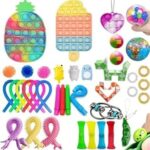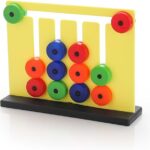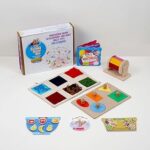Importance of sensory items
For kids with autism, sensory items are vital resources because they facilitate the management of sensory processing issues and create a soothing, stimulating atmosphere. These products are intended to meet the special needs of children with autism who may exhibit hypersensitivity (over-responsiveness) or hyposensitivity (under-responsiveness) to sensory stimuli. These are a few typical sensory objects:
1. Fidget toys:
Goals: Promote calmness, focus, and reduced anxiety.
Examples include textured objects, stretchy bands, stress balls, and spinners.
2. Vests and Blankets with Weights
The goal is to apply deep pressure stimulation, which has the potential to reduce anxiety and be relaxing.
Benefits: Encourages calmness and restful sleep.
3. Use of Chewable Jewellery
Provides a secure means of expressing oral sensory seeking behaviours.
Examples include pencil toppers, bracelets, and chewy necklaces.
4. Earbuds with noise cancellation
Reduce overpowering aural stimuli in loud settings is the goal.
Benefits: Promotes concentration and composure in kids in hectic environments.
5. Timer Images
The goal is to give time management and transitional visual cues.
Benefits: Assist in lowering anxiety related to schedule adjustments.
6. Swings and Balls for Therapy
Goal: Provide proprioceptive and vestibular input to aid in balance and spatial awareness.
Examples include trampolines, treatment swings, and balance balls.
7. Touch Bins
Goal: Use games to stimulate various senses.
Examples: Containers containing water beads, rice, sand, or other tactile elements.
8. Color-changing or light-up toys
The goal is to stimulate vision.
Examples include fibre optic lamps, lava lamps, and light-up toys.
9. Body Socks
Purpose: Offer mild resistance, promoting physical awareness and relaxation.
Advantages: Assists kids in feeling safe and in control.
These sensory products can help children with autism live more comfortable and productive lives by assisting them in navigating their sensory environment. Since every child has different sensory needs, it’s critical to choose the ideal combination of products for them.
SPEECH THERAPY
For kids with autism, speech therapy is a key intervention that helps them acquire vital communication skills. Verbal communication can be difficult for many kids on the autism spectrum, and speech therapy offers structured support to help with this.
Children can enhance their language abilities in understanding and expressing themselves through speech therapy. To promote speech development, therapists employ a range of methods catered to the specific requirements of each child, such as interactive play, gestures, and visual aids. Speech therapy for non-verbal kids may concentrate on non-traditional means of communication, like picture boards, sign language, or gadgets that produce speech.
Beyond helping with language, speech therapy also helps children with autism have better social interactions, experience less frustration, and have a higher quality of life overall. Early and regular speech treatment can have a big impact on a child’s ability to interact with the outside world more successfully.
Various approaches and procedures are used in speech therapy for children with autism, depending on the individual needs and communication difficulties of each kid. Here are a few popular techniques:
- Picture Exchange Communication technique (PECS):
PECS is a communication technique that helps kids who can’t speak articulate their needs and wants by using pictures.
Approach: Kids are taught to trade pictures for items or activities they desire, working their way up from straightforward enquiries to more intricate expressions.
2. Augmentative and Alternative Communication (AAC):
AAC comprises techniques and resources to supplement verbal communication or serve as a substitute for it.
Method: To assist children in communicating, this may entail the use of sign language, communication apps, or speech-generating gadgets.
3. Modelling •
Definition:Modelling is the process of modelling desired actions or words so that the young learns to mimic them.
Approach: During conversations, therapists or other carers continuously model words, phrases, or sentences, encouraging the kid to repeat and pick up new information.
4. Naturalistic Teaching Strategies:
Description: By incorporating speech therapy into regular tasks and activities, these techniques increase the relevance and interest of learning.
Approach: To encourage language use, therapists utilise authentic scenarios, including requesting assistance during play or describing items while out for a stroll.
5. Prompting •
Definition: Prompting offers hints to promote appropriate speech and communication responses.
Method: As the kid gains greater independence, prompts are progressively reduced and can take the form of verbal (e.g., asking questions), visual (e.g., showing a picture), or physical (e.g., directing hand movements).
6. Social Stories
Summary: Social stories are brief, descriptive tales that aid in children’s comprehension of social contexts and suitable reactions.
Approach: To assist children in navigating social encounters, therapists write stories that depict a scenario and anticipated behaviours.
7. Speech Sound Therapy:
Targeting the enhancement of sound articulation and pronunciation.
Approach: To teach proper pronunciation, therapists focus on certain sounds that the kid finds challenging. They do this by employing visual aids, aural clues, and repetition.
8. Interactive Play :
Overview: Play-based treatment promotes language use in an enjoyable manner.
Approach: Toys, games, and engaging activities are used by therapists to help children communicate, take turns, and engage with others.
9. Collaborative Attention Management
Description: The goal of this approach is to help the youngster become more adept at sharing their attention with others, which is a prerequisite for speaking.
Method: To help children improve their capacity to focus on the same thing as others, therapists employ exercises that force the kid to look at an object or person beside them.
10. Reciprocal Imitation Therapy (RIT) •
Synopsis: RIT fosters spontaneous imitation and communication by having the kid mimic the therapist’s movements or noises.
Approach: By playing and modelling behaviours for the child, therapists help foster communication abilities in the youngster.
These techniques can be applied separately or in combination, based on the requirements of the child. Regular and specialised speech treatment can greatly enhance a child’s ability to communicate, enabling them to interact with others and their surroundings more successfully.




































